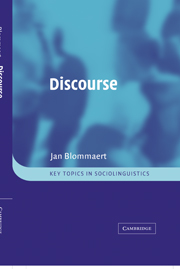Book contents
- Frontmatter
- Contents
- Preface
- Acknowledgments
- 1 Introduction
- 2 Critical Discourse Analysis
- 3 Text and context
- 4 Language and inequality
- 5 Choice and determination
- 6 History and process
- 7 Ideology
- 8 Identity
- 9 Conclusion: Discourse and the social sciences
- Notes
- Appendix: English translations of the documents in chapter 5
- Glossary
- References
- Index
9 - Conclusion: Discourse and the social sciences
Published online by Cambridge University Press: 02 December 2009
- Frontmatter
- Contents
- Preface
- Acknowledgments
- 1 Introduction
- 2 Critical Discourse Analysis
- 3 Text and context
- 4 Language and inequality
- 5 Choice and determination
- 6 History and process
- 7 Ideology
- 8 Identity
- 9 Conclusion: Discourse and the social sciences
- Notes
- Appendix: English translations of the documents in chapter 5
- Glossary
- References
- Index
Summary
Back to basics. I have started this book by saying that a critical analysis of discourse needs to focus on power effects, and in particular on how inequality is produced in, through and around discourse. In order for this to happen, I argued, we need to develop a broadly based approach to language in society, in which the contextualisation of discourse is a central element. If we take context seriously, we have to investigate it seriously. This meant to me that we had to adopt an eclectic register of approaches and methods capable of grasping the full complexity of discourse as a site of inequality. The core of this was ethnography: a perspective on language as intrinsically tied to context and to human activity. I added to this a wide variety of insights from linguistics, pragmatics, and (prominently) sociolinguistics. The ambition was to arrive at a framework that could answer questions raised by a wide range of data, not restricted to the common forms of spoken or written language and not restricted to analyses of data with which the analyst is socially and culturally familiar. If globalisation is accepted as a context in which discourse is produced nowadays – and many scholars subscribe to this – we need to get rid of some of our age-old assumptions of sharedness, community, function, and so forth.
Information
- Type
- Chapter
- Information
- DiscourseA Critical Introduction, pp. 233 - 238Publisher: Cambridge University PressPrint publication year: 2005
